playbook剧本
示例一、对所有受控主机配置yum仓库
powershell
[student@master ansible]$ vim web.yml
[student@master ansible]$ ansible-playbook web.yml
PLAY [repo] ****************************************************************************
TASK [Gathering Facts] *****************************************************************
ok: [node4]
ok: [node3]
ok: [node5]
ok: [node2]
ok: [node1]
TASK [repo1] ***************************************************************************
ok: [node3]
ok: [node4]
ok: [node5]
ok: [node2]
ok: [node1]
TASK [repo2] ***************************************************************************
changed: [node1]
changed: [node5]
changed: [node2]
changed: [node4]
changed: [node3]
PLAY RECAP *****************************************************************************
node1 : ok=3 changed=1 unreachable=0 failed=0 skipped=0 rescued=0 ignored=0
node2 : ok=3 changed=1 unreachable=0 failed=0 skipped=0 rescued=0 ignored=0
node3 : ok=3 changed=1 unreachable=0 failed=0 skipped=0 rescued=0 ignored=0
node4 : ok=3 changed=1 unreachable=0 failed=0 skipped=0 rescued=0 ignored=0
node5 : ok=3 changed=1 unreachable=0 failed=0 skipped=0 rescued=0 ignored=0 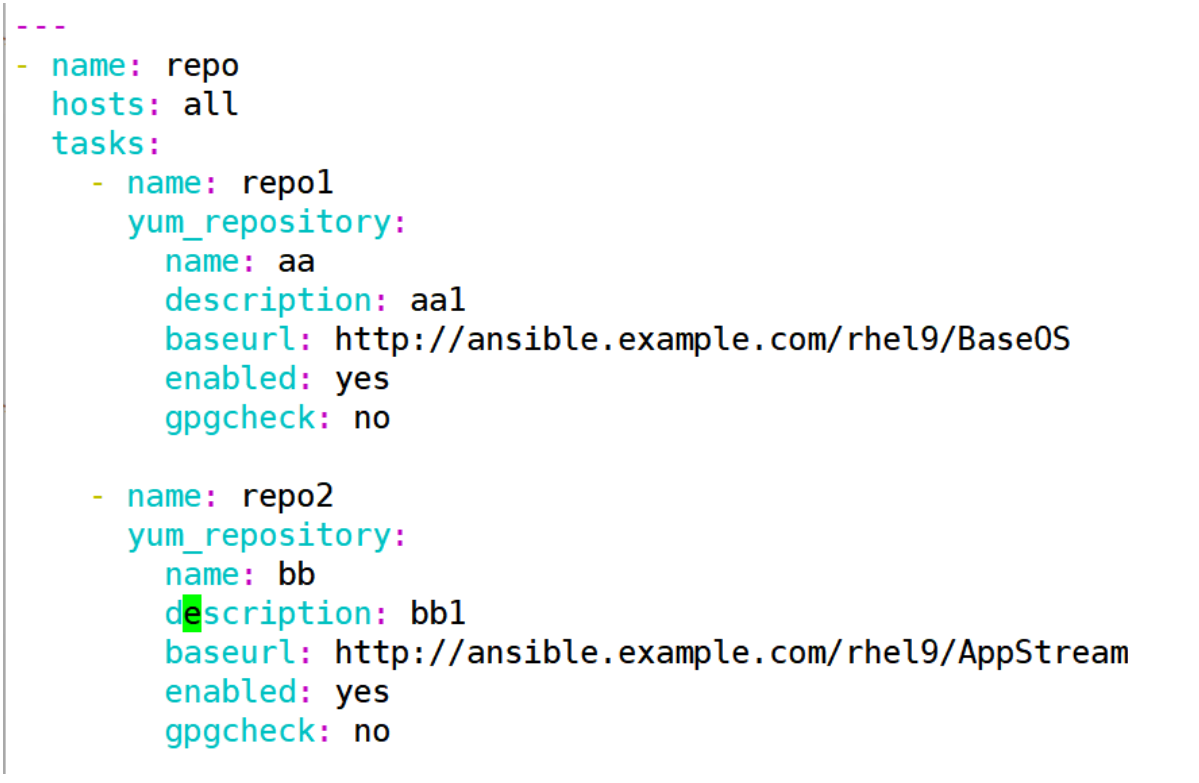
示例二:
1、 安装httpd,在node1执行
2、 开机自启
3、 给/var/www/html目录创建软链接/www
4、 从http://ansible.example.com/index.html下载至/www
5、 能够访问该web站点
powershell
[root@ansible ~]# cd /var/www/html
[root@ansible html]# ls
ansible-automation-platform materials rhel9 roles
[root@ansible html]# vim index.html
[root@ansible html]# cat index.html
welcome
[student@master ansible]$ vim web1.yml
[student@master ansible]$ ansible-playbook web1.yml
PLAY [webstation] **********************************************************************
TASK [Gathering Facts] *****************************************************************
ok: [node1]
TASK [install httpd] *******************************************************************
changed: [node1]
TASK [create link] *********************************************************************
changed: [node1]
TASK [get html] ************************************************************************
changed: [node1]
TASK [restart httpd] *******************************************************************
changed: [node1]
TASK [set firewalld for http] **********************************************************
changed: [node1]
PLAY RECAP *****************************************************************************
node1 : ok=6 changed=5 unreachable=0 failed=0 skipped=0 rescued=0 ignored=0
[student@master ansible]$ curl http://node1
welcome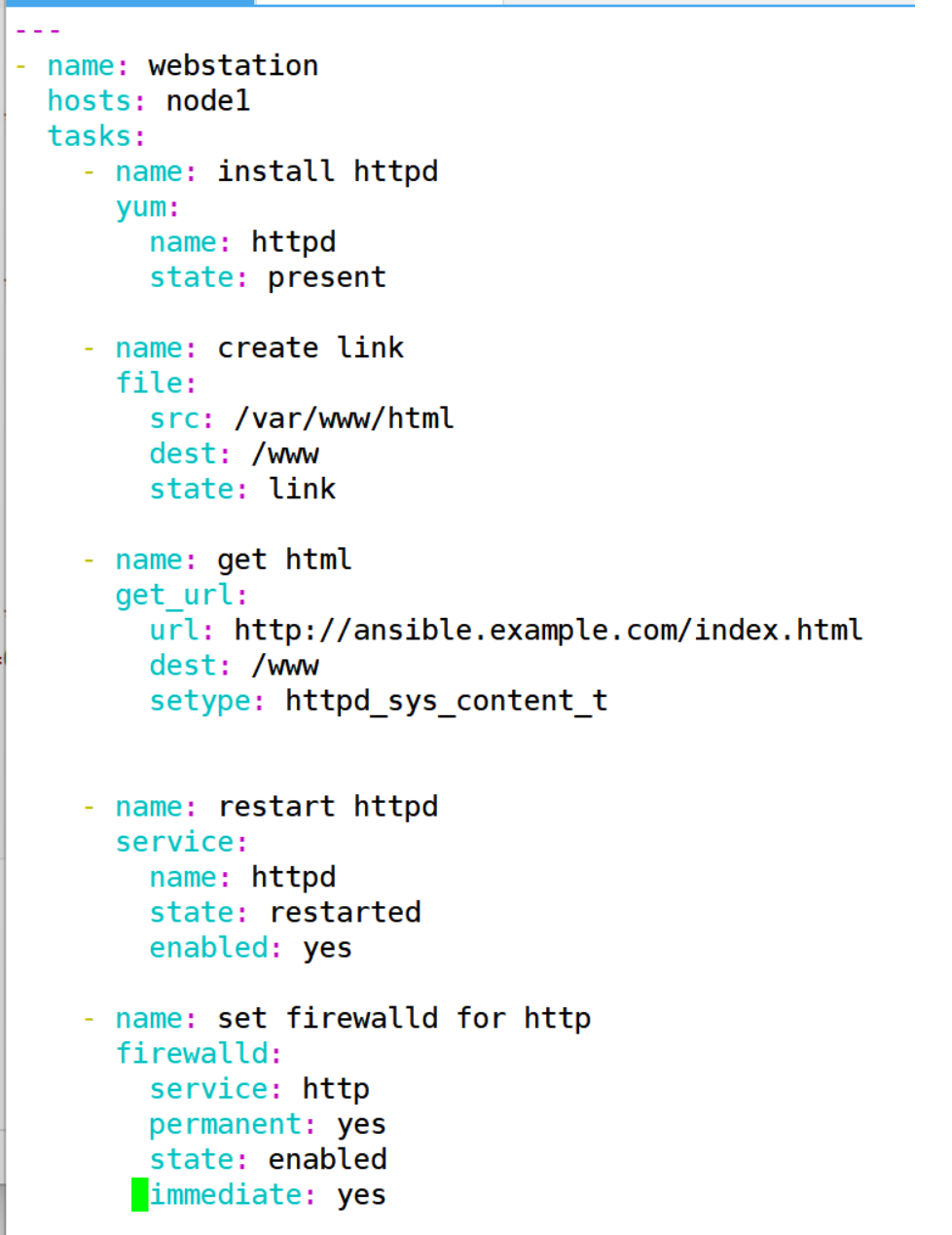
示例三:
notify handlers用法(当完成....任务时,则进行....任务)
1、创建用户user1
2、创建用户user2
3、在创建用户user2之后执行在/tmp下创建文件stw1(也就是在完成创建user2任务后,触发任务stw)
powershell
[student@master ansible]$ vim test.yml
[student@master ansible]$ ansible-playbook test.yml
PLAY [this is a test playbook] *********************************************************
TASK [Gathering Facts] *****************************************************************
ok: [node1]
TASK [create user1] ********************************************************************
changed: [node1]
TASK [create user2] ********************************************************************
changed: [node1]
RUNNING HANDLER [stw] ******************************************************************
changed: [node1]
PLAY RECAP *****************************************************************************
node1 : ok=4 changed=3 unreachable=0 failed=0 skipped=0 rescued=0 ignored=0 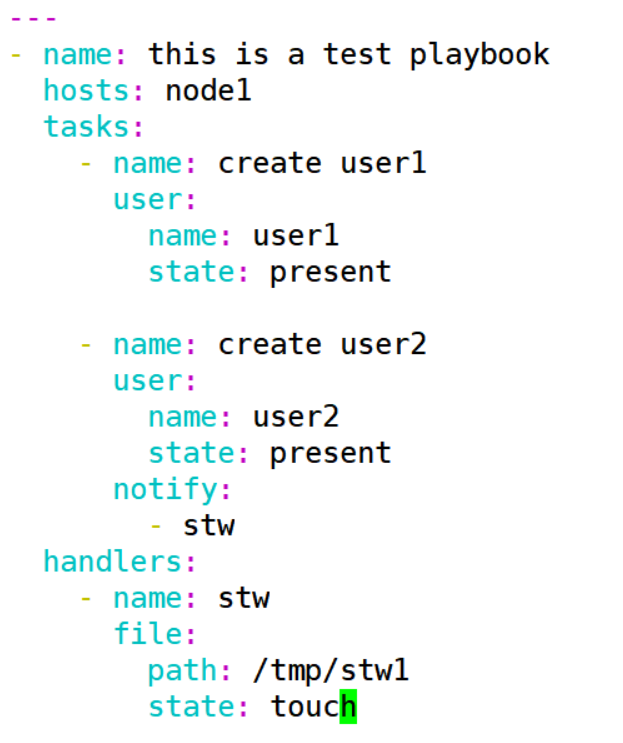
在执行一遍:发现不执行stw任务(因为创建user2任务状态没有改变,只有创建user2任务状态改变时才会执行stw任务)
powershell
[student@master ansible]$ ansible-playbook test.yml
PLAY [this is a test playbook] *********************************************************
TASK [Gathering Facts] *****************************************************************
ok: [node1]
TASK [create user1] ********************************************************************
ok: [node1]
TASK [create user2] ********************************************************************
ok: [node1]
PLAY RECAP *****************************************************************************
node1 : ok=3 changed=0 unreachable=0 failed=0 skipped=0 rescued=0 ignored=0 更改剧本:
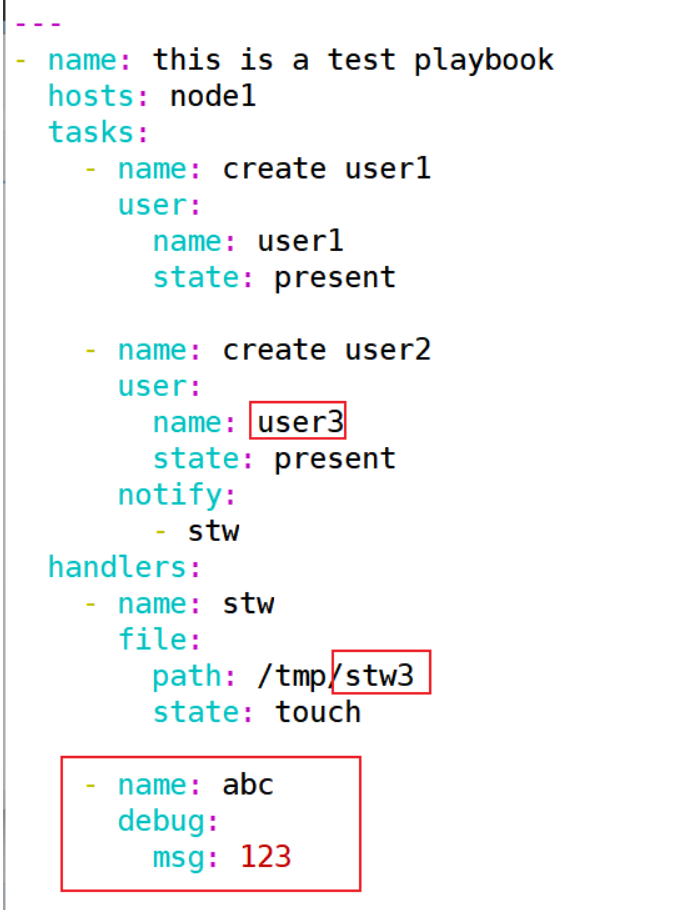
powershell
[student@master ansible]$ ansible-playbook test.yml
PLAY [this is a test playbook] *********************************************************
TASK [Gathering Facts] *****************************************************************
ok: [node1]
TASK [create user1] ********************************************************************
ok: [node1]
TASK [create user2] ********************************************************************
changed: [node1]
RUNNING HANDLER [stw] ******************************************************************
changed: [node1]
PLAY RECAP *****************************************************************************
node1 : ok=4 changed=2 unreachable=0 failed=0 skipped=0 rescued=0 ignored=0 只触发了stw任务,没有触发abc任务(abc任务属于handlers的层级,但是我的notify只写了触发stw任务)
如果想要执行abc任务需要把abc任务写在handlers前面(也就是handlers需要写在剧本的最后)
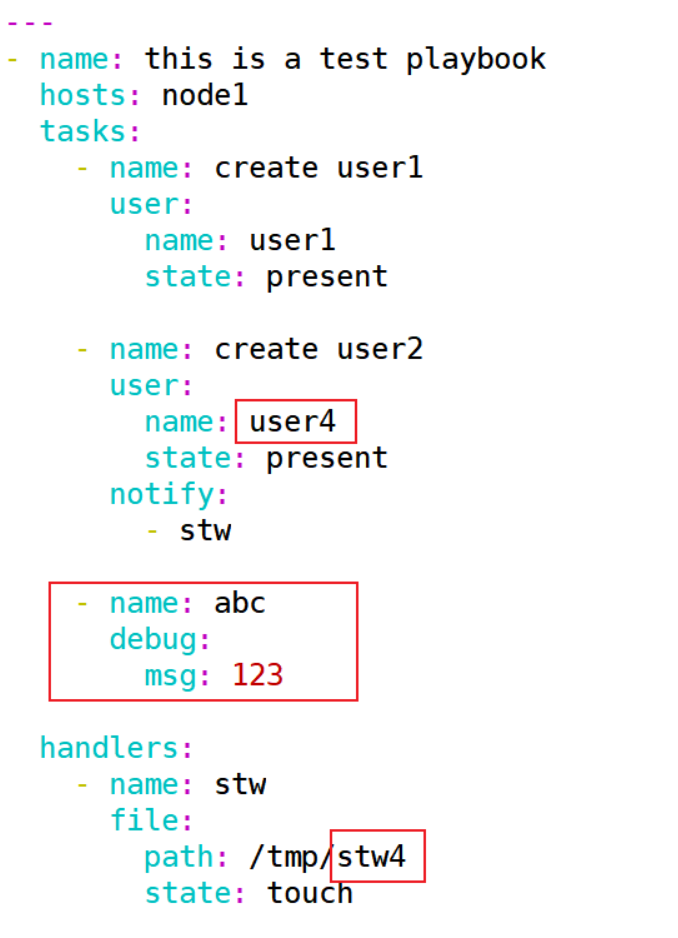
powershell
[student@master ansible]$ ansible-playbook test.yml
PLAY [this is a test playbook] *********************************************************
TASK [Gathering Facts] *****************************************************************
ok: [node1]
TASK [create user1] ********************************************************************
ok: [node1]
TASK [create user2] ********************************************************************
changed: [node1]
TASK [abc] *****************************************************************************
ok: [node1] => {
"msg": 123
}
RUNNING HANDLER [stw] ******************************************************************
changed: [node1]
PLAY RECAP *****************************************************************************
node1 : ok=5 changed=2 unreachable=0 failed=0 skipped=0 rescued=0 ignored=0 handlers任务永远最后执行
示例四:
1、 写一个剧本galaxy.yml,只对node1操作
2、 创建用户aa,该用户不能用于登录,家目录/www1
3、 在/www1创建一个文件html
4、 每次执行该剧本时,将系统的当前时间输入到html文件中
5、 如果html中的时间发生变化,那么创建/tmp/kk的文件
powershell
[student@master ansible]$ vim test1.yml
[student@master ansible]$ ansible-playbook test1.yml
PLAY [test1] ***************************************************************************
TASK [Gathering Facts] *****************************************************************
ok: [node1]
TASK [create user aa] ******************************************************************
changed: [node1]
TASK [create file] *********************************************************************
changed: [node1]
TASK [input html] **********************************************************************
changed: [node1]
RUNNING HANDLER [kk] *******************************************************************
changed: [node1]
PLAY RECAP *****************************************************************************
node1 : ok=5 changed=4 unreachable=0 failed=0 skipped=0 rescued=0 ignored=0 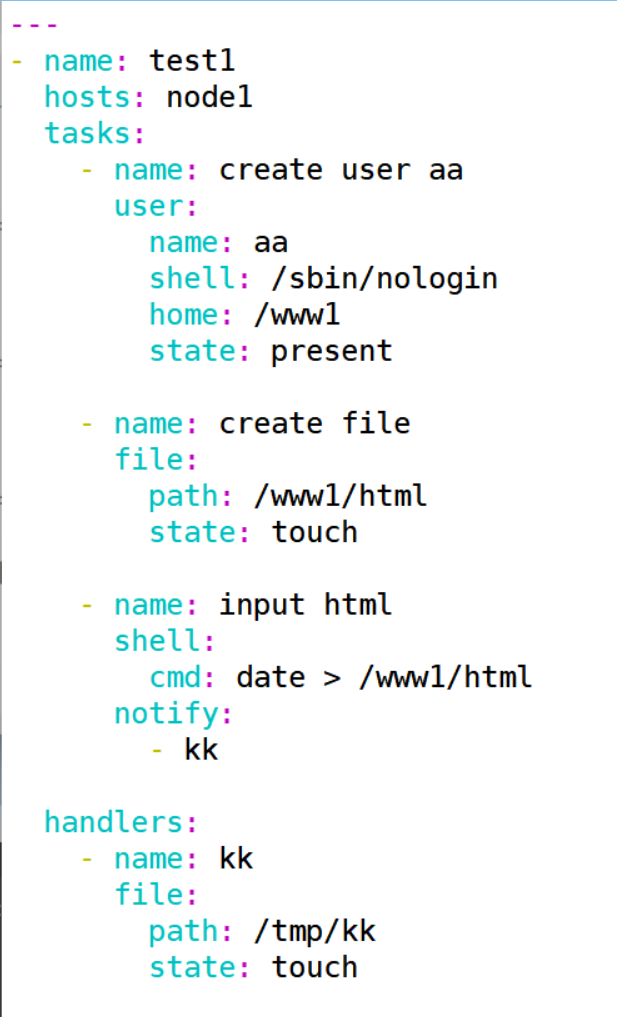
再执行一遍也仍旧触发
powershell
[student@master ansible]$ ansible-playbook test1.yml
PLAY [test1] ***************************************************************************
TASK [Gathering Facts] *****************************************************************
ok: [node1]
TASK [create user aa] ******************************************************************
ok: [node1]
TASK [create file] *********************************************************************
changed: [node1]
TASK [input html] **********************************************************************
changed: [node1]
RUNNING HANDLER [kk] *******************************************************************
changed: [node1]
PLAY RECAP *****************************************************************************
node1 : ok=5 changed=3 unreachable=0 failed=0 skipped=0 rescued=0 ignored=0 因为状态发生了改变,并且不用date,只要使用shell模块,状态都会发生改变
示例五:
tags用法:给任务打标签,一个任务可以有多个标签
ansible-playbook -t 来指定需要指定的任务标签
注意:
其实ansible还预置了5个特殊的tag
always:如果添加此标签,不管是否指定该任务,都执行
never:不执行标签(指定执行时执行此标签任务)
tagged:在执行时使用ansible-playbook playbook.yml -t tagged
只执行带有标签的任务(带never标签的不执行)
untagged:在执行时使用ansible-playbook playbook.yml -t untagged
只执行不带标签的任务,包含always标签也执行
all:所有任务都执行,默认标签
可以同时使用多个标签,需要用","隔开
powershell
[student@master ansible]$ vim a.yml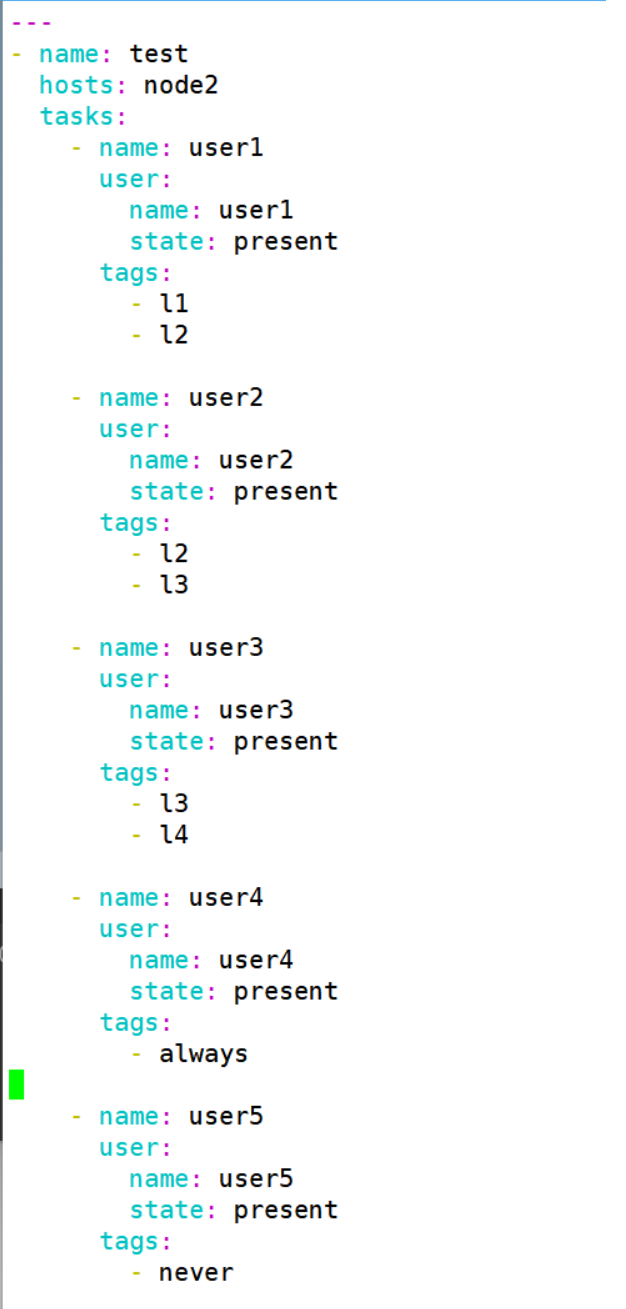
(1)ansible-playbook a.yml -t l2:执行带l2标签的任务,带always标签任务也执行
powershell
[student@master ansible]$ vim a.yml
[student@master ansible]$ ansible-playbook a.yml -t l2
PLAY [test] ****************************************************************************
TASK [Gathering Facts] *****************************************************************
ok: [node2]
TASK [user1] ***************************************************************************
changed: [node2]
TASK [user2] ***************************************************************************
changed: [node2]
TASK [user4] ***************************************************************************
changed: [node2]
PLAY RECAP *****************************************************************************
node2 : ok=4 changed=3 unreachable=0 failed=0 skipped=0 rescued=0 ignored=0 (2)ansible-playbook a.yml -t tagged:执行带标签的任务,不执行带never标签的任务
powershell
[student@master ansible]$ ansible-playbook a.yml -t tagged
PLAY [test] ****************************************************************************
TASK [Gathering Facts] *****************************************************************
ok: [node2]
TASK [user1] ***************************************************************************
ok: [node2]
TASK [user2] ***************************************************************************
ok: [node2]
TASK [user3] ***************************************************************************
changed: [node2]
TASK [user4] ***************************************************************************
ok: [node2]
PLAY RECAP *****************************************************************************
node2 : ok=5 changed=1 unreachable=0 failed=0 skipped=0 rescued=0 ignored=0 (3)ansible-playbook a.yml -t untagged:执行不带标签的任务(这里只执行always)
powershell
[student@master ansible]$ ansible-playbook a.yml -t untagged
PLAY [test] ****************************************************************************
TASK [Gathering Facts] *****************************************************************
ok: [node2]
TASK [user4] ***************************************************************************
ok: [node2]
PLAY RECAP *****************************************************************************
node2 : ok=2 changed=0 unreachable=0 failed=0 skipped=0 rescued=0 ignored=0 (3)ansible-playbook a.yml -t always:执行带always标签的
powershell
[student@master ansible]$ ansible-playbook a.yml -t always
PLAY [test] ****************************************************************************
TASK [Gathering Facts] *****************************************************************
ok: [node2]
TASK [user4] ***************************************************************************
ok: [node2]
PLAY RECAP *****************************************************************************
node2 : ok=2 changed=0 unreachable=0 failed=0 skipped=0 rescued=0 ignored=0 (4)ansible-playbook a.yml -t never:执行带never标签的,并且带always标签的也执行
powershell
[student@master ansible]$ ansible-playbook a.yml -t never
PLAY [test] ****************************************************************************
TASK [Gathering Facts] *****************************************************************
ok: [node2]
TASK [user4] ***************************************************************************
ok: [node2]
TASK [user5] ***************************************************************************
changed: [node2]
PLAY RECAP *****************************************************************************
node2 : ok=3 changed=1 unreachable=0 failed=0 skipped=0 rescued=0 ignored=0 (5)跳过带l2标签的,不执行带never标签的,其余的都执行
powershell
[student@master ansible]$ ansible-playbook a.yml --skip-tags l2
PLAY [test] ****************************************************************************
TASK [Gathering Facts] *****************************************************************
ok: [node2]
TASK [user3] ***************************************************************************
ok: [node2]
TASK [user4] ***************************************************************************
ok: [node2]
PLAY RECAP *****************************************************************************
node2 : ok=3 changed=0 unreachable=0 failed=0 skipped=0 rescued=0 ignored=0 (6)ansible-playbook a.yml:不执行带never标签的,其余的都执行
powershell
[student@master ansible]$ ansible-playbook a.yml
PLAY [test] ****************************************************************************
TASK [Gathering Facts] *****************************************************************
ok: [node2]
TASK [user1] ***************************************************************************
ok: [node2]
TASK [user2] ***************************************************************************
ok: [node2]
TASK [user3] ***************************************************************************
ok: [node2]
TASK [user4] ***************************************************************************
ok: [node2]
PLAY RECAP *****************************************************************************
node2 : ok=5 changed=0 unreachable=0 failed=0 skipped=0 rescued=0 ignored=0